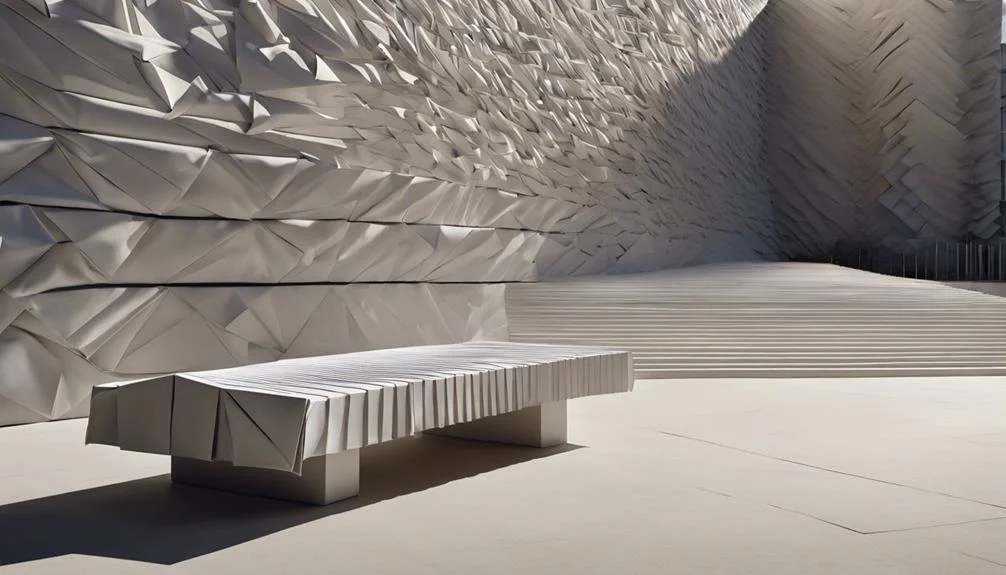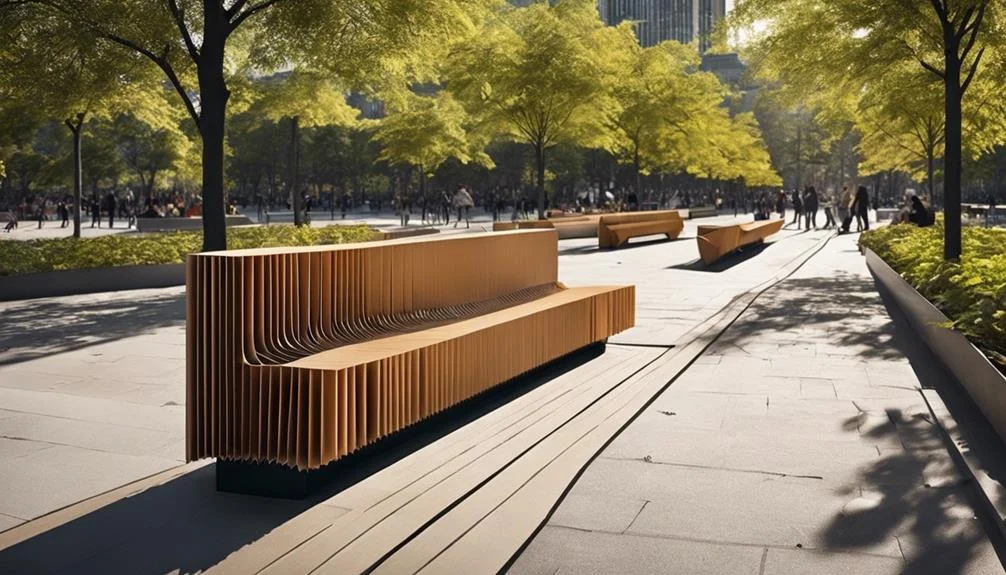The discourse on hostile architecture presents a complex challenge in urban design, balancing between ensuring public safety and inadvertently marginalizing vulnerable populations. Advocates highlight its efficacy in deterring undesirable behavior and maintaining order, underscoring the potential for a more secure and aesthetically pleasing urban environment.
Conversely, critics argue that such measures exacerbate social inequalities, alienating those in dire need of public spaces for shelter and rest. This dichotomy invites a deeper examination into how cities can navigate the fine line between safety and inclusivity, fostering a dialogue on the ethical implications and future prospects of urban design strategies.
Key Takeaways
- Hostile architecture aims to deter unwanted behaviors, enhancing public safety and order.
- Critics argue it discriminates against vulnerable populations, exacerbating social inequality.
- It balances public order with the challenge of maintaining inclusivity and accessibility in urban design.
- Alternatives suggest a compassionate approach to urban planning, emphasizing empathy and community belonging.
Defining Hostile Architecture
What exactly constitutes hostile architecture, and how does it impact our public spaces?
At its core, hostile architecture encompasses design strategies implemented in public spaces that aim to discourage certain behaviors, notably loitering or sleeping. These design elements are not always immediately obvious but can significantly influence how public spaces are used and who feels welcome in them. Examples of such measures include installing spikes on ledges, incorporating armrests on benches to prevent lying down, and designing surfaces to be sloped, making them uncomfortable for extended periods of sitting or sleeping.
This approach to urban design has sparked a considerable amount of controversy. Critics argue that it primarily targets vulnerable populations, such as the homeless, by effectively pushing them out of public sight, thus perpetuating social inequality. This criticism points to a broader debate about the values that inform our public spaces and who they are truly meant to serve.
The underlying contention revolves around whether the implementation of hostile architecture reflects a community's commitment to safety and cleanliness or a deeper, more troubling indifference towards inclusivity and social justice in the fabric of urban life.
The Rationale Behind Implementation

To understand the implementation of hostile architecture, it is essential to consider the various motives that drive urban planners and authorities to adopt these measures in public spaces. The introduction of design elements that are perceived as unwelcoming or deterrents to certain behaviors is not arbitrary. It stems from a calculated decision-making process aimed at addressing specific urban challenges.
Here are the primary reasons behind the implementation:
- Deterrence of Undesired Behaviors: The primary goal is to prevent activities such as loitering, drug use, and vandalism, which are viewed as detrimental to the community's well-being.
- Maintenance of Order and Cleanliness: By discouraging activities that contribute to disorder and uncleanliness, authorities aim to maintain a pristine and orderly environment in public spaces.
- Reduction of Maintenance Costs: Discouraging behaviors that lead to damage or excessive wear and tear on public property helps in keeping maintenance costs down.
- Preservation of Aesthetics and Protection of Property: Ensuring that public spaces remain visually appealing and free from damage is a key consideration in the implementation of hostile architecture.
These motives reflect a complex balance between maintaining public order and addressing broader social issues.
Safety and Order in Public Spaces

Building on the rationale behind the implementation of hostile architecture, it's pertinent to explore its impact on safety and order in public spaces. Advocates of hostile architecture argue that it plays a significant role in deterring criminal activities, such as loitering and drug use, thereby enhancing the safety of these areas. By discouraging unwanted behaviors, it also aids in maintaining order and preventing vandalism and other forms of antisocial behavior in urban environments. The presence of such architectural elements is credited with contributing to cleaner and more secure public spaces, which is pivotal for the well-being of community members and the preservation of public properties.
However, this approach to urban design is not without its critics. While the benefits of increased safety and order are acknowledged, there are ethical concerns regarding the potential for exclusion and discrimination that hostile architecture might entail. This raises the question of how to balance the undeniable benefits of safety and order with the equally important need for inclusivity in public spaces. The challenge lies in designing urban spaces that protect and serve the needs of all community members without inadvertently marginalizing certain groups.
Impact on Vulnerable Populations

Hostile architecture significantly affects vulnerable populations, including the homeless, youth, and individuals with disabilities, by limiting their access to public spaces and exacerbating social exclusion. This deliberate design strategy not only targets these groups but also amplifies their daily struggles, pushing them further to the margins of society.
The consequences of such designs are profound, as they:
- Restrict basic human activities: For the homeless, activities such as resting, sleeping, and seeking shelter in public spaces are made challenging, if not impossible, due to hostile architectural elements.
- Navigate public spaces with difficulty: Individuals with disabilities and the youth are often forced to navigate around these hostile designs, which can lead to further social exclusion and a sense of not belonging.
- Perpetuate social inequality: By making urban environments inhospitable to those most in need, hostile architecture reinforces cycles of homelessness and inequality.
- Exacerbate stigma: The visible nature of hostile designs in public spaces contributes to the stigmatization of vulnerable groups, marking them as unwelcome in the very communities they are part of.
Ethical Considerations

The ethical landscape of urban design is significantly marred by the implementation of hostile architecture, highlighting a pressing need for a reevaluation of priorities in public space planning. This form of design not only excludes but discriminates against vulnerable populations, notably the homeless, raising serious ethical questions. At the heart of the controversy is the fundamental right to public space, which becomes compromised when urban environments are consciously designed to deter certain individuals from using them.
Critics of hostile architecture argue that it not only compromises social equality but also reinforces stigmatization against marginalized groups. By prioritizing order and security over the creation of welcoming and inclusive public spaces, cities inadvertently communicate a lack of empathy and compassion towards those in need. This approach to urban design starkly contrasts with the ideals of social justice and equity, as it visibly prioritizes the comfort of some over the basic human rights of others.
Addressing these ethical concerns necessitates a paradigm shift towards a more compassionate urban design ethos. Such a shift would emphasize inclusivity and empathy, ensuring public spaces are accessible and welcoming to all, regardless of their socio-economic status. This reimagined approach to urban planning would not only enhance the physical landscape of cities but also their moral and ethical fabric.
Alternatives to Hostile Design

In response to the ethical concerns posed by hostile architecture, various inclusive design alternatives have emerged, emphasizing comfort and accessibility for all users of public spaces. These alternatives not only challenge the exclusionary nature of hostile designs but also foster a sense of belonging and community through thoughtful urban planning and design strategies.
To achieve these goals, the following inclusive design strategies are often employed:
- Collaborating with Community Organizations: Involving local communities in the design process ensures that public spaces meet the diverse needs of their users, creating environments that are welcoming and inclusive.
- Universal Accessibility Considerations: Designing public spaces with accessibility in mind ensures that everyone, regardless of ability, can use and enjoy them without facing barriers.
- Policies Promoting Inclusivity in Urban Planning: Implementing forward-thinking policies that prioritize inclusivity can help counteract the effects of hostile architecture, leading to more equitable urban environments.
- Investing in Social Services and Affordable Housing: Addressing the root causes of homelessness and public discomfort through social investment not only improves the well-being of vulnerable populations but also enhances the overall quality of public spaces for all community members.
The Future of Urban Spaces

As we contemplate the trajectory of urban development, it becomes clear that the future hinges on integrating inclusive design principles and technology-driven solutions.
These approaches aim to redefine urban spaces as accessible, engaging, and reflective of community values, ensuring they cater to a broad spectrum of societal needs.
Inclusive Design Principles
Embracing inclusive design principles marks a pivotal step towards creating urban spaces that cater to the diverse needs and activities of all community members. By prioritizing these principles, cities can transform into more welcoming and engaging environments.
Here are key aspects of inclusive design:
- Ensure comfortable seating and ample shade are available to accommodate individuals regardless of age or ability.
- Provide accessible amenities to support a wide range of physical needs, fostering greater independence.
- Foster a sense of belonging and community engagement by designing spaces that encourage social interaction.
- Address social issues through community engagement in the design process, leading to more sustainable and compassionate urban solutions.
Technology-Driven Solutions
Building on the foundation of inclusive design principles, the advent of technology-driven solutions heralds a new era for urban spaces, promising enhanced safety, efficiency, and accessibility. These innovations range from smart benches with sensors for usage tracking and maintenance alerts, to the integration of AI and IoT technologies for improved security through real-time monitoring and threat detection.
Virtual and augmented reality tools offer new ways to design inclusive spaces that prioritize both security and comfort. Additionally, smart lighting systems contribute to safer and more energy-efficient urban environments, while mobile apps and interactive maps provide invaluable real-time information on accessible amenities, events, and community resources, vastly improving the user experience in public spaces.
Conclusion
In conclusion, while hostile architecture may offer temporary solutions for maintaining order and safety in public spaces, its implications on vulnerable populations cannot be overlooked.
The ethical dilemmas it presents, alongside the perpetuation of social inequality, challenge its validity as a long-term strategy for urban design.
Alternatives that prioritize inclusivity and dignity for all individuals are essential for the future of urban spaces, ensuring that design serves to unite rather than divide communities.










